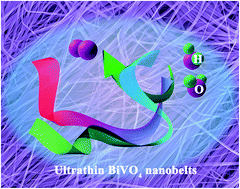Abstract:Ultrathin BiVO4 nanobelts with about 3 nm thickness have been firstly fabricated by a hydrothermal method. It has been discovered that these special nanostructures exhibit much higher photoelectric conversion efficiency as well as water splitting ability than commercial BiVO4 nanoparticles. It is believed that the one-dimensional ultrathin structure of BiVO4 nanobelts is of benefit for the separation and transmission of photoexcited electrons due to its short charge transfer pathway and favourable crystalline structure.

KeyWords Plus:VISIBLE-LIGHT PHOTOCATALYSIS; HYDROGEN-PRODUCTION; THIN-FILMS; NANOSHEETS; IRRADIATION; PERFORMANCE; ELECTRODE; BEHAVIOR
Published in RSC ADVANCES, 6 (77):73136-73139; 10.1039/c6ra15566a 2016


